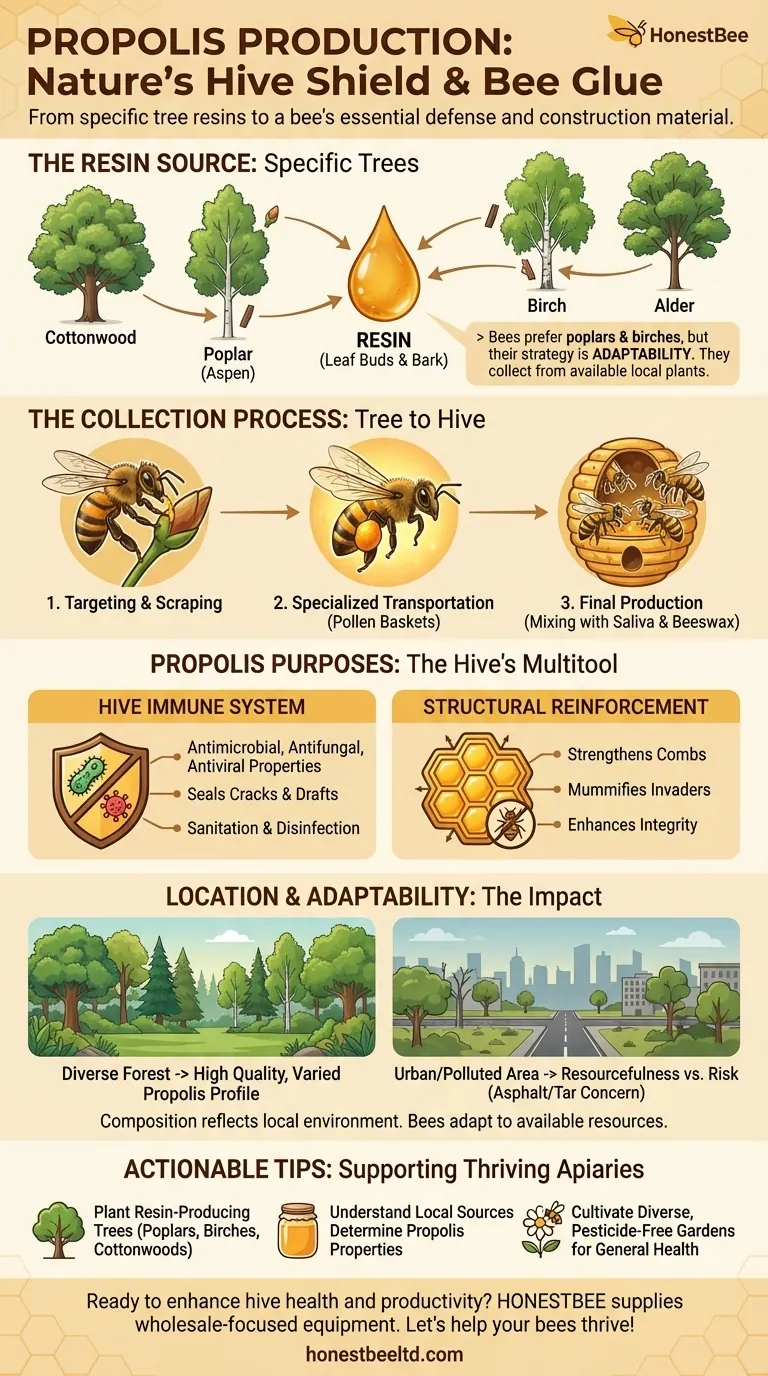To produce propolis, honey bees primarily target resin from specific deciduous trees. They most commonly collect this sticky substance from the leaf buds and bark of cottonwood, poplar (aspen), birch, and alder trees. These resins are the essential raw ingredient for what is often called "bee glue."
While bees show a clear preference for trees like poplars and birches, their true strategy is adaptability. They will collect resinous sap from whichever local plants are available to produce the propolis their hive needs to survive and thrive.

What is Propolis and Why Do Bees Make It?
Propolis is a critical substance for the health and security of a honey bee colony. It is far more than just a simple glue; it is a sophisticated defense mechanism.
The Hive's Immune System
Bees use propolis to seal cracks and unwanted open spaces in the hive, protecting it from drafts and intruders. Its primary function, however, is sanitation.
Propolis has powerful antimicrobial, antifungal, and antiviral properties, effectively disinfecting the hive and protecting the colony from disease.
Structural Reinforcement
Bees also use this resinous mixture to reinforce the structural integrity of their combs. They may even use it to mummify the carcasses of invaders like mice or lizards that are too large for them to remove, preventing the spread of pathogens from the decaying body.
The Collection Process: From Tree to Hive
The creation of propolis is a deliberate and labor-intensive process performed by specialized forager bees.
Targeting the Source
Forager bees seek out plants that exude a sticky, sap-like resin. This material is most often found on flower and leaf buds, but bees will also scrape it from twigs or bark.
Specialized Transportation
The bee uses its mandibles to scrape the resin from the plant. It then transfers the sticky substance to the pollen baskets (corbiculae) on its hind legs for transport back to the hive.
Final Production
Once back in the hive, the forager bee unloads the resin, and other worker bees process it. They chew the resin, mixing it with their own saliva and beeswax to create the final propolis.
Understanding the Trade-offs: The Impact of Location
The exact composition of propolis is not fixed. It is a direct reflection of the bees' local environment, which introduces important variables.
Not All Propolis is Created Equal
Because the plant sources vary by region, the chemical makeup of propolis changes dramatically. Propolis from a North American forest rich in poplar trees will have a different chemical profile than propolis from a European region dominated by birches.
The Principle of Resourcefulness
If preferred trees like poplars are not available, bees will adapt. They will find the next best source of resin in their environment, which could be other trees or even shrubs. This is a testament to their incredible resourcefulness.
A Beekeeper's Concern
While bees are adaptable, a lack of quality resin sources can stress a colony. In urban or polluted areas, bees have been known to collect materials from asphalt, tar, or paint, which can be harmful to the hive.
How to Apply This to Your Goal
For beekeepers and gardeners, understanding the bees' need for resin can help you create a more supportive habitat.
- If your primary focus is supporting local honey bees: Plant or preserve resin-producing trees like poplars, birches, and cottonwoods to provide a high-quality, natural source.
- If your primary focus is harvesting propolis for human use: Recognize that the specific trees in your area will directly determine the color, consistency, and medicinal properties of the propolis you collect.
- If your primary focus is general pollinator health: Cultivate a diverse, pesticide-free garden, as honey bees are incredibly resourceful and will utilize a healthy ecosystem to find what they need.
Ultimately, the story of propolis is a powerful example of the honey bee's remarkable ability to transform its environment into a shield.
Summary Table:
| Key Tree Sources for Propolis Resin | Primary Uses in the Hive |
|---|---|
| Cottonwood, Poplar (Aspen) | Sealing cracks, blocking drafts |
| Birch, Alder | Antimicrobial protection, structural reinforcement |
Ready to support thriving apiaries with quality supplies? HONESTBEE supplies beekeepers and distributors with durable, wholesale-focused equipment to enhance hive health and productivity. Let’s help your bees thrive—contact us today to discuss your needs!
Visual Guide

Related Products
- 2 Frame Stainless Steel Manual Honey Spinner Extractor for Beekeeping
- Stainless Steel 3 Frame Manual Honey Extractor Spinner for Bee Honey Extraction
- HONESTBEE 3-Frame Manual Acrylic Honey Extractor
- Plastic Hand Crank 2 Frame Honey Extractor Low Price
- 8-Frame Electric Self-Reversing Honey Extractor Spinner for Commercial Honey Extraction Equipment
People Also Ask
- How can a pressure washer be used to clean a honey extractor? A Guide to Safe and Efficient Cleaning
- How do beekeepers harvest honey from the honey super? A Step-by-Step Guide to Efficient Extraction
- What are the advantages of tangential honey extractors? Gentle, Affordable Honey Extraction for Your Apiary
- What are some expert tips for cleaning a honey extractor? Protect Your Harvest & Equipment
- Can a manual extractor be upgraded to an electric one? Save Labor & Boost Efficiency



















